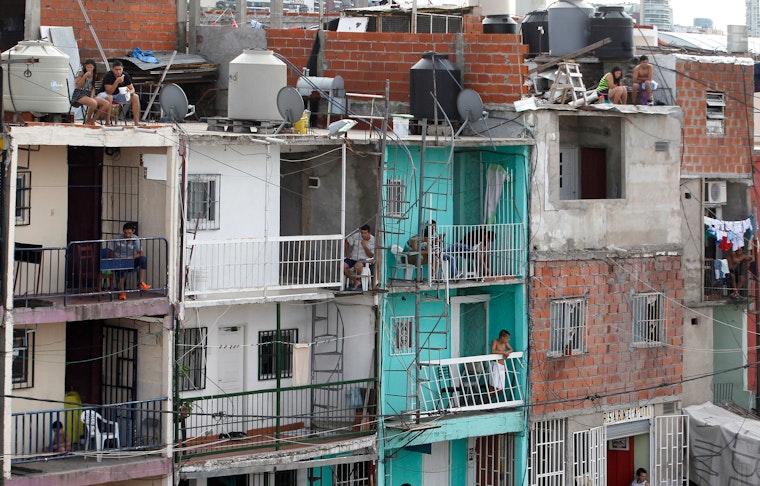How Access to Justice Can Stop a Problem from Turning into a Crisis
By Peter Chapman & Zaza Namoradze

How much does justice cost? Governments typically know how much it costs to run their justice institutions, to pay judges and court staff. But this view doesn’t offer a true picture of the costs of a population struggling to access justice.
How much does it cost not to provide access to justice? In 2013, a study by an Argentinian NGO [link in Spanish], La Asociación Civil por la Igualdad y la Justicia, looked at how people living in slum neighborhoods of Buenos Aires and two other smaller cities were affected by “significant legal events”—events such as family disputes, problems getting access to public benefits or being victims of a crime. Roughly 60 percent of the 600 people surveyed had experienced such an event, mostly over lack of access to government services. Of them 60 percent again said that the trouble had affected their health and well-being; 35 percent said they had lost money, and 14 percent had family problems as a result. The legal trouble affected not just the individual involved, but also family members.
It’s easy to see how this can happen. A problem with an unscrupulous landlord could be avoided by a tenant aware of her rights, with confidence and practical tools to enforce them. Without this, the issue might escalate, creating stress on a breadwinner, resulting in eviction, fueling destructive behavior, and damaging family relationships; losing a home can break up a family. The problem escalates.
Governments don’t regularly think in these terms: what are the costs and what are the savings for a government to invest in legal prevention that might stop a problem from turning into a crisis? How much money does a government spend picking up the pieces, dealing with the symptoms?
Researchers in the United Kingdom, for instance, found that the poor are more likely to experience legal problems and that legal problems often cluster together—one problem leads to another. In country after country, town after town, the most frequent legal problems are civil issues, often affecting nearly half a population. Common problems include consumer disputes, employment issues, challenges accessing health and social benefits, land and property problems, family disputes, complications with neighbors, and debt. Such issues can have significant health impacts.
Despite these important findings, we continue to know far too little about how prevalent legal problems are, what the direct and indirect social and economic costs of unresolved legal problems are to the individuals and the state and what strategies are most effective to respond to such legal issues. That needs to change if countries are to make progress towards Goal 16 of the Sustainable Development Goals, with its commitment to “ensure equal access to justice for all.”
Historically, in too many parts of the world, the notion of “access to justice” has meant only access to courthouses or, in some instances, access to a defense attorney when charged with a crime. While such legal representation is sacrosanct in guaranteeing due process, for most people access to justice extends far beyond the walls of the courthouse—into their neighborhoods and homes. Indeed, researchers found that only five percent of legal problems are settled in court across a range of countries. Large numbers of legal problems go unresolved because of cost, a lack of trust in state institutions or a lack of knowledge of how to proceed. Of those legal issues that are resolved, the vast majority are addressed through direct negotiation with the other party, administrative processes or through community-based dispute resolution.
Flexible forms of legal assistance can result in real benefits and real cost savings. In New York City, an estimate commissioned by the New York City Bar Association found that the city could potentially save $320 million—annually—in shelter savings and affordable housing services by offering legal support to tenants. In New South Wales, Australia, the government stresses flexible legal assistance as “early intervention” to prevent legal problems from escalating.
Improving our understanding of what legal problems are most common and most pressing is essential knowledge for policymakers in crafting meaningful policy. In late 2016, we partnered with the Organization of Co-Operation and Development (OECD) to bring together government statisticians, justice sector officials, researchers and NGOs to advance the ways we understand people’s legal issues, their impacts and effective strategies for resolution. In a two-day technical workshop we discussed tools to understand and respond to people’s day-to-day legal problems.
Much of our conversation focused on tactics to improve how we understand legal issues faced by the population and what these existing tools tell us about effective models to respond. Since the 1980s, more than 30 countries have used legal needs or paths to justice surveys to understand how people resolve their legal problems. These surveys are an essential first step in improving understanding of the most frequent justice and development needs people face and how these issues can be more equitably and effectively addressed. Building on our 2016 workshop, the Justice Initiative—with the OECD, the Praia City Group, national governments, and civil society—will continue to test and implement new tools to help policymakers respond more effectively.
Peter Chapman is a senior policy officer with the Open Society Justice Initiative.

Zaza Namoradze, director of the Open Society Justice Initiative’s Berlin office, oversees programs on legal capacity development, legal empowerment, legal aid reform, and access to justice.